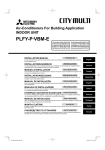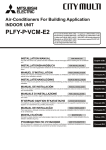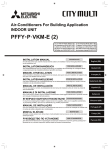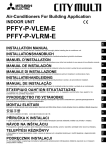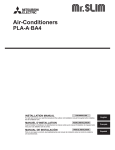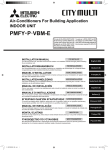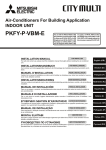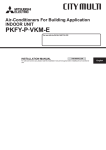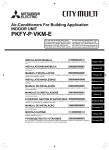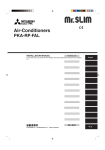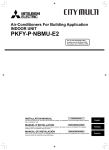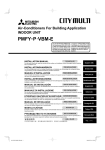Download Mitsubishi Electric PLFY-P-VAM-E Installation manual
Transcript
Air-Conditioners For Building Application INDOOR UNIT PLFY-P·VBM-E INSTALLATION MANUAL FOR INSTALLER For safe and correct use, read this manual and the outdoor unit installation manual thoroughly before installing the air-conditioner unit. INSTALLATIONSHANDBUCH FÜR INSTALLATEURE Aus Sicherheitsgründen und zur richtigen Anwendung vor Installation der Klimaanlage die vorliegende Bedienungsanleitung und das Installationshandbuch gründlich durchlesen. MANUEL D’INSTALLATION Português (P) MONTÖR İÇİN Emniyetli ve doğru kullanım için, klima cihazını monte etmeden önce bu kılavuzu ve dış ünite montaj kılavuzunu tamamıyla okuyun. РУКОВОДСТВО ПО УСТАНОВКЕ Ελληνικά (GR) PARA O INSTALADOR Para uma utilização segura e correcta, leia atentamente este manual e o manual de instalação da unidade exterior antes de instalar o aparelho de ar condicionado. MONTAJ ELKİTABI Italiano (I) ΓΙΑ ΑΥΤΟΝ ΠΟΥ ΚΑΝΕΙ ΤΗΝ ΕΓΚΑΤΑΣΤΑΣΗ Για σωστή και ασφαλή χρήση, διαβάστε προσεκτικά αυτό το εγχειρίδιο, καθώς και το εγχειρίδιο εγκατάστασης της εξωτερικής μονάδας, πριν από την εγκατάσταση της μονάδας κλιματιστικού. MANUAL DE INSTALAÇÃO Español (E) PER L’INSTALLATORE Per un uso sicuro e corretto, prima di installare il condizionatore d’aria leggere attentamente il presente manuale ed il manuale d’installazione dell’unità esterna. ΕΓΧΕΙΡΙΔΙΟ ΟΔΗΓΙΩΝ ΕΓΚΑΤΑΣΤΑΣΗΣ Nederlands (NL) PARA EL INSTALADOR Para un uso seguro y correcto, lea detalladamente este manual de instalación antes de montar la unidad de aire acondicionado. MANUALE DI INSTALLAZIONE Français (F) VOOR DE INSTALLATEUR Lees deze handleiding en de installatiehandleiding van het buitenapparaat zorgvuldig door voordat u met het installeren van de airconditioner begint. MANUAL DE INSTALACIÓN Deutsch (D) POUR L’INSTALLATEUR Avant d’installer le climatiseur, lire attentivement ce manuel, ainsi que le manuel d’installation de l’appareil extérieur pour une utilisation sûre et correct. INSTALLATIEHANDLEIDING English (GB) Türkçe (TR) ДЛЯ УСТАНОВИТЕЛЯ Для обеспечения безопасной и надлежащей эксплуатации внимательно прочтите данное руководство и руководство по установке наружного прибора перед установкой кондиционера. Русский (RU) Contents 1. Safety precautions.....................................................................................2 2. Installing the indoor unit ............................................................................ 2 3. Refrigerant pipe and drain pipe ................................................................. 4 4. Electrical work ...........................................................................................6 5. Installing the grille....................................................................................11 6. Test run (Fig. 6-1)....................................................................................13 Note: The phrase “Wired remote controller” in this installation manual refers only to the PAR-21MAA. If you need any information for the other remote controller, please refer to either the installation manual or initial setting manual which are included in these boxes. 1. Safety precautions : Indicates an action that must be avoided. ► Before installing the unit, make sure you read all the “Safety precautions”. ► Please report to your supply authority or obtain their consent before connecting this equipment to the power supply system. : Indicates that important instructions must be followed. : Indicates a part which must be grounded. Warning: Describes precautions that must be observed to prevent danger of injury or death to the user. : Indicates that caution should be taken with rotating parts. Caution: Describes precautions that must be observed to prevent damage to the unit. : Beware of electric shock. GB After installation work has been completed, explain the “Safety Precautions,” use, and maintenance of the unit to the customer according to the information in the Operation Manual and perform the test run to ensure normal operation. Both the Installation Manual and Operation Manual must be given to the user for keeping. These manuals must be passed on to subsequent users. Warning: • Ask the dealer or an authorized technician to install the air conditioner. • The user should never attempt to repair the unit or transfer it to another location. • Install the unit at a place that can withstand its weight. • Use only specified cables for wiring. The wiring connections must be made securely with no tension applied on the terminal connections. Also, never splice the cables for wiring (unless otherwise indicated in this document). Failure to observe these instructions may result in overheating or a fire. • Use only accessories authorized by Mitsubishi Electric and ask the dealer or an authorized technician to install them. • Do not touch the heat exchanger fins. • Install the air conditioner according to this Installation Manual. • Have all electric work done by a licensed electrician according to local regulations. • The appliance shall be installed in accordance with national wiring regulations. Caution: • Do not use the existing refrigerant piping, when use R410A or R407C refrigerant. • Use ester oil, either oil or alkylbenzene (small amount) as the refrigerator oil to coat flares and flange connections, when use R410A or R407C refrigerant. • Do not use the air conditioner where food, pets, plants, precision instruments, or artwork are kept. • Do not use the air conditioner in special environments. : Indicates that the main switch must be turned off before servicing. : Beware of hot surface. ELV : At servicing, please shut down the power supply for both the Indoor and Outdoor Unit. Warning: Carefully read the labels affixed to the main unit. Caution: Appliances not accessible to the general public. Install the indoor unit at least 2.5 m above floor or grade level. • If the air conditioner is installed in a small room, measures must be taken to prevent the refrigerant concentration from exceeding the safety limit even if the refrigerant should leak. • If the supply cord is damaged, it must be replaced by the manufacturer, its service agent or similarly qualified persons in order to avoid a hazard. • The cut face punched parts may cause injury by cut, etc. The installers are requested to wear protective equipement such as gloves, etc. • When installing or relocating, or servicing the air conditioner, use only the specified refrigerant (R410A) to charge the refrigerant lines. Do not mix it with any other refrigerant and do not allow air to remain in the lines. If air is mixed with the refrigerant, then it can be the cause of abnormal high pressure in the refrigerant line, and may result in an explosion and other hazards. The use of any refrigerant other than that specified for the system will cause mechanical failure or system malfunction or unit breakdown. In the worst case, this could lead to a serious impediment to securing product safety. • • • • • • • • Ground the unit. Install an leak circuit breaker, as required. Use power line cables of sufficient current carrying capacity and rating. Use only a circuit breaker and fuse of the specified capacity. Do not touch the switches with wet fingers. Do not touch the refrigerant pipes during and immediately after operation. Do not operate the air conditioner with the panels and guards removed. Do not turn off the power immediately after stopping operation. 2. Installing the indoor unit 2.1. Check the indoor unit accessories (Fig. 2-1) The indoor unit should be supplied with the following accessories. Accessory name Fig. 2-1 2 Q’ty Installation template 1 Washers (with insulation) Washers (without insulation) 4 Pipe cover (for refrigerant piping joint) Small diameter Large diameter Band (large) Band (small) Screw with washer (M5 × 25) for mounting grille Drain socket Insulation 4 1 1 6 2 4 1 1 2. Installing the indoor unit 2.2. Ceiling openings and suspension bolt installation locations (Fig. 2-2) 20-45 20-45 160 20-45 (7.5) * 50-70 *105 17 +5 0 +5 17 0 35 Min. 2500 135 C D 160 840 • Using the installation template (top of the package) and the gauge (supplied as an accessory with the grille), make an opening in the ceiling so that the main unit can be installed as shown in the diagram. (The method for using the template and the gauge is shown.) * Before using, check the dimensions of template and gauge, because they change due to fluctuations of temperature and humidity. * The dimensions of ceiling opening can be regulated within the range shown in Fig. 2-2; so center the main unit against the opening of ceiling, ensuring that the respective opposite sides on all sides of the clearance between them becomes identical. • Use M10 (3/8") suspension bolts. * Suspension bolts are to be procured at the field. • Install securely, ensuring that there is no clearance between the ceiling panel & grille, and between the main unit & grille. 950 +35 860-910 605 -5 620 160 840 150 90 187.5 Caution: Install the indoor unit at least 2.5 m above floor or grade level. (7.5) 160 * When the optional multi-functional casement is installed, add 135mm to the dimensions marked on the figure. (mm) Models 32, 40, 50, 63, 80 100, 125 Fig. 2-2 # 100 100 90 100 130 90 120° 120° *158 *167 *155 70° 350 C 241 281 D 258 298 2.3. Branch duct hole and fresh air intake hole (Fig. 2-3) " Grille Ceiling Multi function casement (option) Entire periphery * Note that the space between ceiling panel of the unit and ceiling slab and etc must be 10 to 15 mm. Min. 500 Outer side of main unit Bolt pitch Ceiling opening Outer side of Grille ! Fig. 2-3 At the time of installation, use the duct holes (cut out) located at the positions shown in Fig. 2-3, as and when required. • A fresh air intake hole for the optional multi function casement can also be made. Note: •The figure marked with * in the drawing represent the dimensions of the main unit excluding those of the optional multi function casement. * When installing the optional multi function casement, add 135 mm to the dimensions marked on the figure. • When installing the branch ducts, be sure to insulate adequately. Otherwise condensation and dripping may occur. • When installing the fresh air intake hole, be sure to remove the insulator # that is pasted on the indoor unit. Branch duct hole Indoor unit Fresh air intake hole Drain pipe Refrigerant pipe Branch duct hole diagram (view from either side) 14-ø2.8 burring hole ø150 cut out hole ø175 burring hole pitch Fresh air intake hole diagram 3-ø2.8 burring hole ø125 burring hole pitch ø100 cut out hole ! Ceiling " Detailed figure of removing the insulator # Insulator 2.4. Suspension structure (Give site of suspension strong structure) (Fig. 2-4) Unit Grille Pillar 605 0 81 Ceiling Rafter Beam Roof beam Use inserts rated at 100-150kg each (procure locally) Suspension bolts M10 (3/8") (procure locally) Steel reinforcing rod Fig. 2-4 • The ceiling work differs according to the construction of the building. Building constructors and interior decorators should be consulted for details. (1) Extent of ceiling removal: The ceiling must be kept completely horizontal and the ceiling foundation (framework: wooden slats and slat holders) must be reinforced in order to protect the ceiling from vibration. (2) Cut and remove the ceiling foundation. (3) Reinforce the ends of the ceiling foundation where it has been cut and add ceiling foundation for securing the ends of the ceiling board. (4) When installing the indoor unit on a slanted ceiling, attach a pillar between the ceiling and the grille and set so that the unit is installed horizontally. Wooden structures • Use tie beams (single storied houses) or second floor beams (two story houses) as reinforcing members. • Wooden beams for suspending air conditioners must be sturdy and their sides must be at least 6 cm long if the beams are separated by not more than 90 cm and their sides must be at least 9 cm long if the beams are separated by as much as 180 cm. The size of the suspension bolts should be ø10 (3/8"). (The bolts do not come with the unit.) Ferro-concrete structures • Secure the suspension bolts using the method shown, or use steel or wooden hangers, etc. to install the suspension bolts. 3 GB 950 860-910 810 20-45 2. Installing the indoor unit Suspension bolt Ceiling Nut Washer (with insulation) Mounting plate Washer (without insulation) Check using the Installation gauge 105 (240) +5 0 17 Min. 30 A=17 +50 Caution: Use the top half of the box as a protective cover to prevent dust or debris from getting inside the unit prior to installation of the decorative cover or when applying ceiling materials. Fig. 2-5 Main unit Ceiling Gauge Ceiling opening dimensions 2.6. Confirming the position of main unit and tightening the suspension bolts (Fig. 2-7) Fig. 2-6 GB Main unit Ceiling Installation template (top of the package) Screw with washer (Accessory) 2.5. Unit suspension procedures (Fig. 2-5) Suspend the main unit as shown in the diagram. Figures given in parentheses represent the dimensions in case of installing optional multi function casement. 1. In advance, set the parts onto the suspension bolts in the order of the washers (with insulation), washers (without insulation) and nuts (double). • Fit the washer with cushion so that the insulation faces downward. • In case of using upper washers to suspend the main unit, the lower washers (with insulation) and nuts (double) are to be set later. 2. Lift the unit to the proper height of the suspension bolts to insert the mounting plate between washers and then fasten it securely. 3. When the main unit can not be aligned against the mounting hole on the ceiling, it is adjustable owing to a slot provided on the mounting plate. • Make sure that A is performed within 17-22 mm. Damage could result by failing to adhere to this range. (Fig. 2-6) Fig. 2-7 • Using the gauge attached to the grille, ensure that the bottom of the main unit is properly aligned with the opening of the ceiling. Be sure to confirm this, otherwise condensation may form and drip due to air leakage, etc. • Confirm that the main unit is horizontally levelled, using a level or a vinyl tube filled with water. • After checking the position of the main unit, tighten the nuts of the suspension bolts securely to fasten the main unit. • The installation template (top of the package) can be used as a protective sheet to prevent dust from entering the main unit when the grilles are left unattached for a while or when the ceiling materials are to be lined after installation of the unit is finished. * As for the details of fitting, refer to the instructions given on the Installation template. 3. Refrigerant pipe and drain pipe 3.1. Refrigerant and drainage piping locations of indoor unit The figure marked with * in the drawing represent the dimensions of the main unit excluding those of the optional multi function casement. (Fig. 3-1) 24 B 90 A 60 284 377 * 170 * 140 * 190 (mm) Models 32, 40, 50 63, 80, 100, 125 øA 90° ± 0.5° .4 R0 0.8 -R 4 dimensions marked on the figure. Copper pipe O.D. (mm) ø6.35 ø9.52 ø12.7 ø15.88 ø19.05 Fig. 3-2 * When the optional multi-functional casement is installed, add 135 mm to the • When commercially available copper pipes are used, wrap liquid and gas pipes with commercially available insulation materials (heat-resistant to 100 °C or more, thickness of 12 mm or more). • The indoor parts of the drain pipe should be wrapped with polyethylene foam insulation materials (specific gravity of 0.03, thickness of 9 mm or more). • Apply thin layer of refrigerant oil to pipe and joint seating surface before tightening flare nut. • Use two wrenches to tighten piping connections. • Use refrigerant piping insulation provided to insulate indoor unit connections. Insulate carefully. Flare cutting dimensions 45° ± 2° B 74 77 Drain pipe Ceiling Grille Refrigerant pipe (liquid) Refrigerant pipe (gas) Water supply inlet Main unit 3.2. Connecting pipes (Fig. 3-2) Fig. 3-1 A 80 85 Flare dimensions øA dimensions (mm) 8.7 - 9.1 12.8 - 13.2 16.2 - 16.6 19.3 - 19.7 22.9 - 23.3 Warning: When installing the unit, securely connect the refrigerant pipes before starting the compressor. 3. Refrigerant pipe and drain pipe Refrigerant pipe sizes & Flare nut tightening torque R407C or R22 Liquid pipe Gas pipe Tightening Tightening Pipe size Pipe size torque torque (mm) (mm) (N.m) (N.m) ODø6.35 (1/4”) 14 - 18 ODø12.7 (1/2”) 49 - 61 ODø9.52 (3/8”) 14 - 18* ODø15.88 (5/8”) 49 - 61* ODø9.52 (3/8”) 34 - 42 ODø15.88 (5/8”) 68 - 82 ODø9.52 (3/8”) 34 - 42 ODø19.05 (3/4”) 68 - 82* P20/25/32/40 P50 P63/80 P100/125 R410A Liquid pipe Gas pipe Tightening Tightening Pipe size Pipe size torque torque (mm) (mm) (N.m) (N.m) ODø6.35 (1/4”) 14 - 18 ODø12.7 (1/2”) 49 - 61 ODø6.35 (1/4”) 14 - 18 ODø12.7 (1/2”) 49 - 61 ODø9.52 (3/8”) 34 - 42 ODø15.88 (5/8”) 68 - 82 ODø9.52 (3/8”) 34 - 42 ODø15.88 (5/8”) 68 - 82 Flare nut O.D. Liquid pipe (mm) Gas pipe (mm) 17 17 22 22 26 26 29 29 * Connect the joint with the following pipes: Liquid and gas pipes of P50, gas pipe of P100/P125. insulating material Pipe cover (large) Pipe cover (small) Refrigerant pipe (gas) Refrigerant pipe (liquid) Band Cross-sectional view of connection Pipe Insulating material Squeeze Apply refrigerating machine oil over the entire flare seat surface. * Do not apply refrigerating machine oil to the screw portions. (This will make the flare nuts more apt to loosen.) Be certain to use the flare nuts that are attached to the main unit. (Use of commercially-available products may result in cracking.) 3.3. Indoor unit (Fig. 3-3) Heat insulation for refrigerant pipes: 1 Wrap the enclosed large-sized pipe cover around the gas pipe, making sure that the end of the pipe cover touches the side of the unit. 2 Wrap the enclosed small-sized pipe cover around the liquid pipe, making sure that the end of the pipe cover touches the side of the unit. 3 Secure both ends of each pipe cover with the enclosed bands. (Attach the bands 20 mm from the ends of the pipe cover.) • After connecting the refrigerant piping to the indoor unit, be sure to test the pipe connections for gas leakage with nitrogen gas. (Check that there is no refrigerant leakage from the refrigerant piping to the indoor unit.) 3.4. Drainage piping work (Fig. 3-4) Fig. 3-3 • Use VP25 (O.D. ø32 (1-1/4”) PVC TUBE) for drain piping and provide 1/100 or more downward slope. • Be sure to connect the piping joints using a polyvinyl type adhesive. • Observe the figure for piping work. • Use the included drain hose to change the extraction direction. Max. 20m 1.5–2m Correct piping Wrong piping Insulation (9 mm or more) Downward slope (1/100 or more) Support metal Air bleeder Raised Odor trap Max. 15cm Grouped piping O. D. ø32 PVC TUBE Make it as large as possible Indoor unit Make the piping size large for grouped piping. Downward slope (1/100 or more) O. D. ø38 PVC TUBE for grouped piping. (9 mm or more insulation) Up to 85 cm 1. Connect the drain socket (supplied with the unit) to the drain port. (Fig. 3-5) (Fix the tube using PVC adhesive then secure it with a band.) 2. Install a locally purchased drain pipe (PVC pipe, O.D. ø32). (Fix the pipe using PVC adhesive then secure it with a band.) 3. Insulate the tube and pipe. (PVC pipe, O.D. ø32 and socket) 4. Check that drain flows smoothly. 5. Insulate the drain port with insulating material, then secure the material with a band. (Both insulating material and band are supplied with the unit.) Fig. 3-4 (mm) , 11 25 25 25 Fig. 3-5 Unit Insulating material Band (large) Drain port (transparent) Insertion margin Matching Drain pipe (O.D. ø32 PVC TUBE) Insulating material (purchased locally) Transparent PVC pipe O.D. ø32 PVC TUBE (Slope 1/100 or more) Band (small) Drain socket 5 GB Refrigerant pipe and 4. Electrical work 4.1. Indoor unit (Fig. 4-1) 1. 2. 3. 4. Remove the electrical wiring service panel. Remove the electrical box cover. Remove the MA Remote controller terminal cover. Wire the power cable and control cable separately through the respective wiring entries given in the diagram. • Do not allow slackening of the terminal screws. • Leave excess cable so that the electrical box cover can be suspended below the unit during servicing. (Approx. 50 to 100 mm) Entry for remote controller cable Entry for power and control cable Clamp Electrical box cover Service panel for electrical wiring Temporary hook for electrical box cover MA Remote controller terminal cover Power supply terminals (with earth terminal) (L, N, Transmission terminals (M1, M2, S) MA Remote controller terminal (1, 2) Secure with the clamp ) 4.2. Power supply wiring • Wiring size must comply with the applicable local and national code. • Install an earth longer than other cables. • Power supply codes of appliance shall not be lighter than design 60245 IEC 53 or 60227 IEC 53. • A switch with at least 3 mm contact separation in each pole shall be provided by the air conditioner installation. Power cable size : more than 1.5 mm2 GB Warning: Never splice the power cable or the indoor-outdoor connection cable, otherwise it may result in a smoke, a fire or communication failure. ► Use earth leakage breaker (NV). For breaker, means shall be provided to ensure disconnection of all active phase conductors of the supply. Fig. 4-1 [Fig. 4-2] Switch 16 A Overcurrent protection 16 A Indoor unit Total operating current be less than 16 A Pull box 4.3. Types of control cables 1. Wiring transmission cables L N TB2 Fig. 4-2 Types of transmission cable Cable diameter Length M1 M2 S TB5 1 2 TB15 Shielding wire CVVS or CPEVS More than 1.25 mm² Less than 200 m 2. M-NET Remote control cables Types of remote control cable Shielding wire MVVS Cable diameter 0.5 to 1.25 mm² Add any portion in excess of 10 m to within the Length longest allowable transmission cable length 200 m 3. MA Remote control cables Types of remote control cable 2-core cable (unshielded) Cable diameter 0.3 to 1.25 mm² Length Less than 200 m 6 4. Electrical work M1 M2 TB3 1 2 TB5 M1 M2 S TB15 M1 M2 M1 M2 S TB3 M1 M2 S TB5 TB5 TB3 CN90 Pair No. 0 M1 M2 1 2 TB15 TB5 4.4. Connecting remote controller, indoor and outdoor transmission cables (Fig. 4-3) M1 M2 S CN90 M1 M2 S 1 2 9 TB5 Pair No. 0 TB15 M1 M2 S 1 2 9 TB5 TB15 • Connect indoor unit TB5 and outdoor unit TB3. (Non-polarized 2-wire) The “S” on indoor unit TB5 is a shielding wire connection. For specifications about the connecting cables, refer to the outdoor unit installation manual. • Install a remote controller following the manual supplied with the remote controller. • Connect the remote controller’s transmission cable within 10 m using a 0.75 mm2 core cable. If the distance is more than 10 m, use a 1.25 mm2 junction cable. MA Remote controller • Connect the “1” and “2” on indoor unit TB15 to a MA remote controller. (Nonpolarized 2-wire) • DC 9 to 13 V between 1 and 2 (MA remote controller) M-NET Remote controller • Connect the “M1” and “M2” on indoor unit TB5 to a M-NET remote controller. (Non-polarized 2-wire) • DC 24 to 30 V between M1 and M2 (M-NET remote controller) Wireless remote controller(When installing wireless signal receiver) • Connect the wire of wireless signal receiver (9-pole cable) to CN90 of indoor controller board. • When more than two units are run under group control using wireless remote controller, connect TB15 each with the same number. • To chang Pair No. setting, refer to installation manual attached to wireless remote controller. (In initial setting of indoor unit and wireless remote controller, Pair No. is 0.) Terminal block for indoor transmission cable Pair No. 0 Terminal block for outdoor transmission cable(M1(A), M2(B), Remote controller wireless signal receiver wireless remote controller Fig. 4-3 SWA 3 2 1 SWB 2 3 4 4.5. Setting addresses (Fig. 4-4) CN43 SW1 ON OFF CN82 1 2 3 4 5 6 7 8 9 10 9 D 7 8 5 6 7 8 E F0 1 2 3456 2 3 2 3 4 5 6 (10ths DIGIT) SW14 0 1 BC 0 1 SWC 4 9 SW11 789A SW12 ./ . (BRANCH No.) (1s DIGIT) (S)) GB Fig. 4-4 (Be sure to operate with the main power turned OFF.) • There are 2 types of rotary switch setting available: setting addresses 1 to 9 and over 10, and setting branch numbers. How to set addresses Example: If Address is “3”, remain SW12 (for over 10) at “0”, and match SW11(for 1 to 9) with “3”. How to set branch numbers SW14 (Series R2 only) Match the indoor unit’s refrigerant pipe with the BC controller’s end connection number. Remain other than series R2 at “0”. • The rotary switches are all set to “0” when shipped from the factory. These switches can be used to set unit addresses and branch numbers at will. • The determination of indoor unit addresses varies with the system at site. Set them referring to the Data Book. Address board 4.6. Switch setting for high ceiling or at the time of changing the number of air outlets (Fig. 4-4) With this unit, the air flow rate and fan speed can be adjusted by setting the SWA and SWB (slide switch). Select a suitable setting from the table below according to the installation location. * Make sure the SWA and SWB switch are set, otherwise problems such as not getting cool/warm may occur. ■ PLFY-P32-P80VBM SWA SWB 4 direction Silent 2.5 m Standard 2.7 m High ceiling 3.5 m 3 direction 2.7 m 3.0 m 3.5 m 2 direction 3.0 m 3.3 m 3.5 m ■ PLFY-P100,P125VBM SWA SWB 4 direction 3 direction 2 direction Silent 2.7 m 3.0 m 3.3 m Standard 3.2 m 3.6 m 4.0 m High ceiling 4.5 m 4.5 m 4.5 m 4.7. Sensing room temperature with the built-in sensor in a remote controller (Fig. 4-4) If you want to sense room temperature with the built-in sensor in a remote controller, set SW1-1 on the control board to “ON”. The setting of SW1-7 and SW1-8 as necessary also makes it possible to adjust the airflow at a time when the heating thermometer is OFF. 7 4. Electrical work 4.8. How to set the fixed up/down air direction (Only for wired remote controller) Horizontal airflow Downward • For PLFY-BM, only the particular outlet can be fixed to certain direction with the procedures below. Once fixed, only the set outlet is fixed every time air conditioner is turned on. (Other outlets follow UP/DOWN air direction setting of the remote controller.) ■ Explanation of word • "Address No. of indoor unit" is the number given to each air conditioner. • "Outlet No." is the number given to each outlet of air conditioner. (Refer to the right.) • "Up/Down air direction" is the direction (angle) to fix. Remote controller setting Fixed setting The airflow direction of this outlet is controlled by the airflow direction setting of remote controller. The airflow direction of this outlet is fixed in particular direction. * When it is cold because of direct airflow, the airflow direction can be fixed horizontally to avoid direct airflow. Outlet No.3 Outlet No.4 MITSUBISHI ELECTRIC label Outlet No.2 Reset 1 horizontal 2 3 4 Outlet No.1 5 Note: "0" indicates all outlets. GB Operation buttons (During the fixed airflow direction mode) Press the button with either Address No. of indoor unit or outlet No. blinking, ... ON/OFF button TEMP. MENU BACK PAR-21MAA MONITOR/SET Resets the fixed airflow direction mode. Fan Speed button ON/OFF ON/OFF FILTER DAY CHECK TEST OPERATION CLOCK Filter button (<Enter> button) Press for 2 seconds to change / cancel "Fixed airflow direction mode". Only the air conditioner with the No. on remote controller and its outlet are set to the setting 5 of the airflow direction. (Other outlets are closed.) It is used to identify the air conditioner and outlet to set. Sends the information on remote controller display. CLEAR Check button (Clear button) Press the button with Up/Down air direction indicater which is blinking Refer to the next page for details. Attention Mode button (Return button) Moves between the selected(blinking) parts. Outlet No. Up/Down air direction Set temperature buttons Down Address No. of indoor unit Up Changes the selection(No.). Outlet No. "1-4"or "0" 8 Up/Down air direction Address No. of indoor unit 5 steps or "01-50" cancel Only the air conditioner with the No. on Remote controller and its outlet are fixed at "Up/Down air direction" which is blinking. This is used only to decide direction conclusively. Attention: Be careful not to set wrong air conditioner. 4. Electrical work < Process for setting > [1] To turn off air conditioner and change the remote controller to "Fixed airflow direction mode" 1.Press ON/OFF button to turn off the air conditioner. button for more than 2 seconds 2.Press Fan Speed button and Filter simultaneously and it becomes the fixed airflow direction mode after a while. [4] To cancel "Fixed airflow direction mode" 1.Press ON/OFF button to cancel "Fixed airflow direction mode".It is also button for more than canceled by pressing Fan Speed button and Filter 2 seconds simultaneously. 2.Do not operate remote controller for 30 seconds after the "Fixed airflowdirection mode" is canceled. It does not accept even if it is operated. "Fixed airflow direction mode" display Air blows downward after it becomes "fixed airflow direction mode" GB [2] To select and identify the outlet to set 1.Press Set Temperature button to change number with the outlet No. blinking. Select outlet No. to set. Outlet No. Outlet No.3 Up/Down air direction Address No. of indoor unit Outlet No.4 MITSUBISHI ELECTRIC label Outlet No.2 Outlet No.1 Note: "0" indicates all outlets. button to send the information on remote controller. 2.Press Filter 3. Wait for 15 seconds . How does the air conditioner run? → Only the air from the selected outlet blows downward. → Go to step[3]. → Air from the wrong outlet blows downward. → Repeat 1 and set again. → All outlets are closed. → The number of the air conditioner (Address No. of indoor unit) is wrong. Refer to How to find air conditioner No.. [3] To fix air direction 1.Press Mode button (Return button) to blink Up/Down air direction indicater. 2.Press Set Temperature button until the direction to set is chosen. button to send the information on remote controller to air 3.Press Filter conditioner. 4.Wait for 15 seconds . How does the air conditioner run? → Airflow direction is set in the selected direction. → The fixed setting completed (Go to step [4].) → Airflow direction is set in the wrong direction. → Repeat 2. and set again. Outlet No. Up/Down air direction Address No. of indoor unit Air direction changes This indicates NO FIXED SETTING(canceled) 9 4. Electrical work ■ How to find air conditioner No. ● Each air conditioner has its own Address No. of indoor unit (Example below). ● Address No. of indoor unit can be set ranging from "01" to "50". ● To find air conditioner No. to set, refer to the procedures below. [2] To check by changing Address No. of indoor unit. one after the other (Maximum unit No. is 50) 1.Press Mode button (Return button) and Address No. of indoor unit blinks. Air conditioner No. is found by its airflow direction with Address No. of indoor unit changed one after the other. Example) Structure of the system Outlet No. Indoor unit (00) 01 Switch setting of the address (00) 02 (00) 03 Address No. of indoor unit MA remote controller Addres No. of indoor unit Adjust to the next address No.with Set Temperature button . 2. Press Filter button to send the information on remote controller. 3. Wait for 15 seconds after sending. How does the air conditioner run? → Only the outlet which No. displayed on remote controller blows downward. → No. displayed in remote controller is air conditioner No. (Checking completed) → All outlets are closed. → Repeat [1] and continue this procedure. → "Err" is displayed on remote controller. → This groupe does not have this address No. of indoor unit.(Go back to [1] and continue .) GB When the Switch setting of the address is "00", address No. of indoor unit is given automatically. Up/Down air direction Indoor unit Switch setting of the address Err (01) 01 (02) 02 (03) 03 Address No. of indoor unit MA remote controller When the Switch setting of the address is not "00", switch setting of the address is also address No. of indoor unit. <Process to find air conditioner No.> [1] To check Address No. of indoor unit 1.Press Mode button (Return button) and Address No. of indoor unit blinks. Adjust address No. of indoor unit to "01" with Set Temperature button . Outlet No. Up/Down air direction Address No. of indoor unit button to send the information on remote controller. 2.Press Filter 3. Wait for 15 seconds . How does the air conditioner run? → Only air from the outlet which No. displayed on remote controller blows downward. → Address No.01 of indoor unit is the air conditioner No.. → All outlets are closed. → Go to step [2]. 10 To clear fixed setting To clear all fixed setting(reset to initial setting), press check button(clear botton) for more than 3 seconds in fixed airflow direction mode. Display of remote controller blinks and the set information is cleared. Note: This operation clears the fixed setting information of all air conditioner connected to the remote controller. 5. Installing the grille 5.1. Checking the contents (Fig. 5-1) • This kit contains this manual and the following parts. 20 Accessory name Grille Screw with captive washer Gauge Fastener Screw Screw i-see sensor corner panel Q’ty 1 4 1 3 4 1 1 Remark 950 × 950 (mm) M5 × 0.8 × 25 (Divided into four parts) 4×8 4 × 12 for PLP-6BAE 5.2. Preparing to attach the grille (Fig. 5-2) • With the gauge supplied with this kit, adjust and check the positioning of the unit relative to the ceiling. If the unit is not properly positioned relative to the ceiling, it may allow air leaks or cause condensation to collect. • Make sure that the opening in the ceiling is within the following tolerances: 860 × 860 - 910 × 910 • Make sure that A is performed within 17-22 mm. Damage could result by failing to adhere to this range. A=17 +50 Fig. 5-1 Main unit Ceiling Gauge (inserted into the unit) Fig. 5-2 5.2.1. Removing the intake grille (Fig. 5-3) • Slide the levers in the direction indicated by the arrow to open the intake grille. • Unlatch the hook that secures the grille. * Do not unlatch the hook for the intake grille. • With the intake grille in the “open” position, remove the hinge of the intake grille from the grille as indicated by the arrow . 5.2.2. Removing the corner panel (Fig. 5-4) • Remove the screw from the corner of the corner panel. Slide the corner panel as indicated by the arrow to remove the corner panel. [Fig.5-3, 5-4] Fig. 5-3 Intake grille Grille Intake grille levers Grille hook Hole for the grille’s hook Corner panel Fig. 5-4 Screw Detail 4-directional 3-directional 1 pattern: Initial setting 4 patterns: 1 air outlet fully closed Blowout direction patterns 2-directional 6 patterns: 2 air outlet fully closed 5.3. Selection of the air outlets For this grille the discharge direction is available in 11 patterns. Also, by setting the remote controller to the appropriate settings, you can adjust the airflow and speed. Select the required settings from the Table 1 according to the location in which you want to install the unit. 1) Decide on the discharge direction pattern. 2) Be sure to set the remote controller to the appropriate settings, according to the number of air outlets and the height of the ceiling on which the unit will be installed. Note: For 3- and 2-directional, please use the air outlet shutter plate (option). Blowout direction patterns 5.4. Installing the grille 5.4.1. Preparations (Fig. 5-5) • Install the 2 enclosed screws with washer in the main unit (at the corner drain pipe area and at the opposite corner) as shown in the diagram. 15-20 Table 1 Main unit Screw with captive washer Fig. 5-5 11 GB Ceiling opening dimensions 5. Installing the grille 5.4.2. Temporary installation of the grille (Fig. 5-6) Main unit Corner drain pipe area Screw with washer (for temporary use) Grille Screw with washer Socket Bell shaped hole 5.4.3. Securing the grille (Fig. 5-7) • Secure the grille to the main unit by tightening the previously installed 2 screws (with captive washer) as well as the 2 remaining screws (with captive washer). * Make sure that there are no gaps between the main unit and the grille or the grille and the ceiling. Fixing gaps between the grille and the ceiling With the grille attached, adjust the height of the main unit to close the gap. Caution: When tightening the screw with captive washer , tighten it at a torque of 4.8 N•m or less. Never use an impact screwdriver. • It may result in parts damage. • Temporarily secure the grille using the bell shaped holes by putting the socket of the grille marked on the corner drain pipe area of the main unit. * Make sure that the lead wiring of the grille does not get pinched between the grille and the main unit. Fig. 5-6 Ceiling Main unit Grille Make sure that there are no gaps Adjust the nut of the main unit using GB a wrench, etc. 5.4.4. Wire connection (Fig. 5-8) • Remove the 2 screws fixing the cover of electrical branch box of the unit and open the cover. • Be sure to connect the connector (white, 20-pole) for vane motor of the grille to CNV connector of controller board of the unit. The lead wire of grille is passed through the catch for bell mouth of the unit perfectly. The remaining lead wire is tied with clamp of the unit and put the cover of the unit again with 2 screws. Note: Do not put the remaining lead wire in electrical branch box of the unit. Fig. 5-7 5.5. Installing the intake grille (Fig. 5-9) Clamp of the main unit Electrical box Indoor controler board Catch for bell mouth Lead wire of grille Fig. 5-8 Note: When reinstalling the corner panels (each with a safety wire attached), connect the other end of each safety wire to the grille using a screw (4 pcs, 4 × 8) as shown in the illustration. *If the corner panels are not attached, they may fall off while the unit is operating. • Perform the procedure that is described in “5.2. Preparing to attach the grille” in reverse order to install the intake grille and the corner panel. • Multiple units can be installed with grille so that the position of the logo on each corner panel is consistent with the other units regardless of the orientation of the intake grille. Align the logo on the panel according to the wishes of the customer as shown in the diagram to the left. (The position of the grille can be changed.) Refrigerant piping of the main unit Drain piping of the main unit Initial position of the corner panel (logo attached) * Installation in any position is possible. Initial position of the levers on the intake grille * Although the clips can be installed in any of 4 positions, the configuration shown here is recommended. (It is not necessary to remove the intake grille when maintenance is performed on the electric component box of the main unit.) i-see sensor (PLP-6BAE panel) Screw (4×8) Corner panel Safety wire (Enlarged) Controller board CN4Y Controller board CN6Y 2 fasteners Fastener i-see sensor corner panel Rib for grille Screw Fig. 5-10 12 Fig. 5-9 5.6. Installation of i-see sensor corner panel (Fig. 5-10) For PLP-6BAE panel • Take the lead wires CN4Y (white) and CN6Y (red) of the i-see sensor corner panel from the side of the electrical box on the unit and make sure to conect them to the connector of the controller board. • Lead wires of the i-see sensor corner panel should be fixed at the rib of the grille with the fastener so that there is no slack. • Lead wires should be held together with the lead wires of the unit and fixed with 2 of the fastener so that there is no slack. • Put the cover back on the electrical box with 3 screws. * Make sure wires are not caught in the cover of electric box. If they are caught, they will be cut. • Adverse procedure of “5.2. Preparing to attach the grille” will be taken for installing the i-see sensor corner panel. * The i-see sensor corner panel should be fixed onto the grille with screw . 5. Installing the grille 5.7. Locking the up/down airflow direction (Fig. 5-11) Button Vane motor Up/down vanes Connector The vanes of the unit can be set and locked in up or down orientations depending upon the environment of use. • Set according to the preference of the customer. The operation of the fixed up/down vanes and all automatic controls cannot be performed using the remote controller. In addition, the actual position of the vanes may differ from the position indicated on the remote controller. Turn off the main power switch. Injuries or an electrical shock may occur while the fan of the unit is rotating. Disconnect the connector for the vane motor of the vent that you want to lock. (While pressing the button, remove the connector in the direction indicated by the arrow as shown in the diagram.) After removing the connector, insulate it with tape. It also can be set by remote controller. Refer to 4.7. 5.8. Check Fig. 5-11 • Make sure that there is no gap between the unit and the grille, or between the grille and the surface of the ceiling. If there is any gap between the unit and the grille, or between the grille and the surface of the ceiling, it may cause dew to collect. • Make sure that the wires have been securely connected. • For PLP-6BAE, check the rotating movement of the i-see sensor. If the i-see sensor does not rotate, review the procedure in “5.6. Installation of i-see sensor corner panel”. GB 6. Test run (Fig. 6-1) 6.1. Before test run ► After completing installation and the wiring and piping of the indoor and outdoor units, check for refrigerant leakage, looseness in the power supply or control wiring, wrong polarity, and no disconnection of 1 phase in the supply. ► Use a 500-volt megohmmeter to check that the resistance between the power supply terminals and ground is at least 1.0 MΩ. TEST RUN COOL, HEAT °C °C SIMPLE TEMP. ON/OFF MENU BACK MONITOR/SET PAR-21MAA ON/OFF DAY CHECK TEST OPERATION CLOCK FILTER "! CLEAR ON/OFF button Test run display Liquid pipe (Indoor unit) temperature display ON/OFF lamp Power display Error code display Test run remaining time display Set temperature button Mode selection button Air direction button TEST button ! Fan Speed button " Louver button ► Do not carry out this test on the control wiring (low voltage circuit) terminals. Warning: Do not use the air conditioner if the insulation resistance is less than 1.0 MΩ. 6.2. Test run Using wired remote controller (Fig. 6-1) Turn on the power at least 12 hours before the test run. “TEST RUN” liquid crystal display Press the [TEST] button twice. Press the [Mode selection] button and switch to the cooling (or heating) mode. Make sure that cold (or warm) wind is blown out. Make sure that the wind speed is switched. Press the [Fan speed] button. Press the [Air direction button] or [Louver button]. Check operation of the vane or louver. Check operation of the outdoor unit fan. Stop Release test run by pressing the [ON/OFF] button. Register a telephone number. The telephone number of the repair shop, sales office, etc., to contact if an error occurs can be registered in the remote controller. The telephone number will be displayed when an error occurs. For registration procedures, refer to the operation manual for the indoor unit. Fig. 6-1 Note: • If an error code is displayed on the remote controller or if the air conditioner does not operate properly, refer to the outdoor unit installation manual or other technical materials. • The OFF timer is set for the test run to automatically stop after 2 hours. • During the test run, the time remaining is shown in the time display. • During the test run, the temperature of the indoor unit refrigerant pipes is shown in the room temperature display of the remote controller. • When the VANE or LOUVER button is pressed, the message “NOT AVAILABLE” may appear on the remote controller display depending on the indoor unit model, but this is not a malfunction. Water supply pump Water (about 1000cc) Drain plug Pour water through outlet · Be carefule not to spray water into the drain pump mechanism. 6.3. Check of drainage (Fig. 6-2) • Ensure that the water is being properly drained out and that no water is leaking from joints. When electric work is completed. · Pour water during cooling operation and check. When electric work is not completed. · Pour water during emergency operation and check. * Drain pan and fan are activated simultaneously when single phase 220-240V is turned on to L and N on terminal block after the connecter (SWE) on controller board in the electrical branch box is set to ON. Be sure to turn it back to the former state after work. Fig. 6-2 13 This product is designed and intended for use in the residential, commercial and light-industrial environment. The product at hand is • Low Voltage Directive 2006/95/EC based on the following • Electromagnetic Compatibility Directive 2004/108/EC EU regulations: • Machinery Directive 2006/42/EC • Energy-related Products Directive 2009/125/EC * * Only P32/40/50/63/80/100 • RoHs Directive 2011/65/EU Please be sure to put the contact address/telephone number on this manual before handing it to the customer. HEAD OFFICE: TOKYO BLDG., 2-7-3, MARUNOUCHI, CHIYODA-KU, TOKYO 100-8310, JAPAN RG79D836K02 Printed in UNITED KINGDOM














